
Aphids of Economic Importance in Montana
This publication is a general identification guide for aphids found in Montana that can have an economic impact on crops. It includes pictorial keys of economic aphids by crop and species, and details on aphid pests for grain, alfalfa, potato and soybean crops.
Last Updated: 12/17by Cecil I. Tharp, Sue L. Blodgett and Patricia M. Denke, Department of Entomology, Montana State University, Bozeman
APHIDS (1/16 TO 1/8 INCH LONG) ARE COMMONLY
found throughout Montana, from the dry-land agriculture of northern Montana to the irrigated Yellowstone River valley. They are found in almost all major crops including corn, cereals, sugar beets, alfalfa and potatoes, with infestations often reaching economically significant levels.
Aphids may damage plants by sucking plant juices, which directly weakens the plant, by injecting toxins from their saliva that cause curled leaves and malformations, or by transmitting diseases that cause secondary plant injury.
There are many different species of aphids inhabiting Montana agricultural systems. Economic thresholds, monitoring techniques and treatments vary according to which aphid is targeted. For this reason, correctly identifying aphids to species is a critical concern for producers and professionals across the state. This guide is a tool to help professionals and producers correctly identify non-winged aphids in order to facilitate quicker responses to their individual needs.
Identification of aphids
Aphids are 1/16 to 1/8 inch long, pear-like insects that may be winged or wingless. They usually have two cornicles, or tailpipes, that protrude off the upper surface of the abdomen. Aphids secrete excess sap, or honeydew, from the anus as they feed, which leaves a sticky residue on plant surfaces. This residue indicates aphid presence in fields.
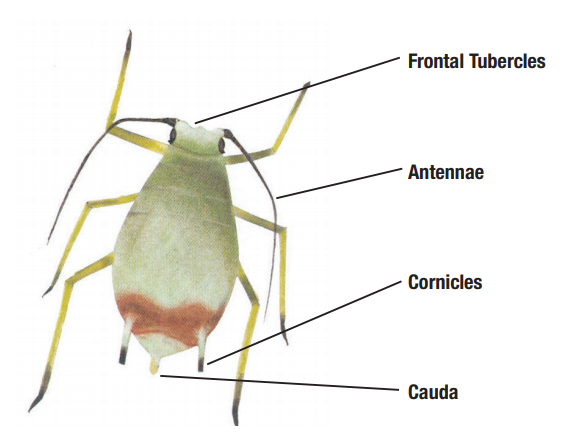
Pictoral key to economic aphids found in Montana by species.
Using the keys: To identify an aphid, begin at #1. Determine whether the insect better matches the description in 1a or 1b. Then proceed to the number that the key directs you to, and so on, until you reach an identification. After reaching an identification, go on to the illustrated table noted to find description, host plants, feeding locations and other comments.
| #1 | 1a. | Abdomen light-colored with dark spots having spines, eyes red | Spotted Alfalfa Aphid (see table 2, p. 6) |
| 1b. | Aphids not as above | See #2 in this key | |
| # 2 | 2a. | Aphid color gray-black; appendages are white and black | Cowpea Aphid (see table 2, p. 6) |
| 2b. | Aphid color blue-green; 3rd antennal segment brown | Blue Alfalfa Aphid (see table 2, p. 6) | |
| 2b. | Aphids not as above | See #3 in this key | |
| # 3 | 3a. | Antennae over 1/2 long as body | See #4 in this key |
| 3b. | Antennae under 1/2 as long as body | See #9 in this key | |
| # 4 | 4a. | Cornicles pale | See #12 in this key |
| 4b. | Cornicles all black or tips black | See #5 in this key | |
| # 5 | 5a. | Entire cornicle, antennae and leg joints black | English Grain Aphid (see table 1, p. 4) |
| 5b. | Tips of cornicles black | See #6 in this key | |
| #6 | 6a. | Orange pattern on abdomen | Bird Cherry Oat Aphid (see table 1, p. 4) |
| 6b. | Not as above | See #7 in this key | |
| # 7 | 7a. | Tubercles converge; 3 longitudinal stripes on abdomen | Green Peach Aphid (see table 4, p. 7) |
| 7b. | Antennal tubercles do not converge (b). Does not have 3 longitudinal stripes on abdomen | See #8 in this key | |
| # 8 | 8a. | Antennae reaching past base of cornicles, light-colored with dark bands at each segment | Pea Aphid (see table 4, p. 7) |
| 8b. | Antennae not reaching past base of cornicles | See #11 in this key | |
| # 9 | 9a. | Cornicles not visible or barely visible | See #10 in this key |
| 9b. | Cornicles prominent and visible, abdomen with dark area at base of cornicles, or all dark cornicles | Corn Leaf Aphid (see table 1, p. 4) | |
| # 10 | 10a. | Tip of abdomen with one appendage | Western Wheat Aphid (see table 1, p. 5) |
| 10b. | Tip of abdomen with two appendages | Russian Wheat Aphid (see table 1, p. 5) | |
| # 11 | 11a. | Aphid 1/16 inch or less, lighter green to yellow | Soybean Aphid (see table 5, p. 8) |
| 11b. | Aphid > 1/16 inch, dark green with dark mid stripe down dorsal side | Greenbug (see table 1, p. 4) | |
| # 12 | 12a. | Lighter green to white insect, cauda pronounced | Potato Aphid (see table 3, p. 7) |
| 12b. | Uniformly dark antennae, greenish in color, no mid-stripe down dorsal side | Rose Grass Aphid (see table 1, p. 5) | |
| 12c. | Light green with dark mid-stripe down dorsal side | Greenbug (see table 1, p. 4) |
Pictoral key to economic aphids found in Montana by crop.
| Grains (See illustrations, Table 1, pp. 4- 5) | |||
| #1 | 1a. | Antennae less than 2?3 as long as body | See #2 in the grains section of this key |
| 1b. | Antennae more than 2?3 as long as body | See #4 in the grains section of this key | |
| #2 | 2a | Cornicles very small, difficult to see | See #3 in the grains section of this key |
| 2b. | Cornicles visible, black at tips or entirely black | See #7 in the grains section of this key | |
| #3 | 3a. | Tip of abdomen with two appendages | Russian Wheat Aphid (see table 1, p. 5) |
| 3b. | Tip of abdomen with only one appendage | Western Wheat Aphid (p.10) | |
| #4 | 4a. | Cornicles entirely black | English Grain Aphid (see table 1, p. 4) |
| 4b. | Cornicles black only at tips or entirely pale | See #5 in the grains section of this key | |
| #5 | 5a. | Abdomen reddish-orange near base of cornicles or entirely dark gray to black | Bird Cherry Oat Aphid (see table 1, p. 4) |
| 5b. | Abdomen entirely green | See #6 in the grains section of this key | |
| #6 | 6a. | Cornicles and legs completely pale | Rose Grass Aphid (see table 1, p. 5) |
| 6b. | Dorsal stripe down midline, not as above | Greenbug (see table 1, p. 4) | |
| #7 | 7a. | Blue to olive colored insect with tips of cornicles black | Corn Leaf Aphid (see table 1, p. 4) |
| 7b. | Green colored insect with a dorsal midline stripe down abdomen. Only tips of cornicles black | Greenbug (see table 1, p. 4) | |
| Potato (See illustrations, Tables 3 and 4, p. 7) | |||
| #1 | 1a. | Cornicles short; 3 longitudinal dark stripes down abdomen | Green Peach Aphid (see table 4, p. 7) |
| 1b. | Cornicles long | See #2 in the potato section of this key | |
| #2 | 2a. | Cornicles dark at least at tip | Pea Aphid (see table 4, p. 7) |
| 2b. | Cornicles pale | Potato Aphid (see table 3, p. 7) | |
| Alfalfa (See illustrations, Tables 2 and 4, pp. 6-7) | |||
| #1 | 1a. | Light green with 3 longitudinal stripes down abdomen | Green Peach Aphid (see table 4, p. 7) |
| 1b. | Not as above | See #2 in the alfalfa section of this key | |
| #2 | 2a. | Body green-blue; 3rd antennal segment dark | Blue Alfalfa Aphid (see table 2, p. 6) |
| 2b. | Body black | Cowpea Aphid (see table 2, p. 6) | |
| 2c. | Not as above | See #3 in the alfalfa section of this key | |
| #3 | 3a. | Pale yellow with spots; red eyes | Spotted Alfalfa Aphid (see table 2, p. 6) |
| 3b. | Not as above | See #4 in the alfalfa section of this key | |
| #4 | 4a. | Cornicles have color, body is green | Pea Aphid (see table 4, p. 7) |
| 4b. | Pale cornicles, body light yellow to white | Potato Aphid (see table 3, p. 7) | |
| Soybean (See illustrations, Table 5, p. 8) | |||
| #1 | 1a. | Very small, 1?16" or less. Light Green | Soybean Aphid (see table 5, p. 8) |
TABLE 1. Aphids in Montana Grains
| Bird Cherry Oat Aphid | |
| Description: | Olive-green to black aphids are about 2mm long, and have a characteristic orange or red band across the back of the abdomen. |
| Host plants: | Bird Cherry Oat aphids can be found on corn, sorghum, wheat and barley. |
| Feeding location: | Generally in the whirl of the plant. |
| Misc. comments: | Principle vector of barley yellow dwarf virus. |
| Corn Leaf Aphid | |
| Description: | Corn leaf aphids are bluish-green to dark olive in color, with a purplish patch around the base of the cornicles. Cornicles are completely dark. |
| Host plants: | Corn leaf aphid is found primarily on corn, especially late in season. However, this pest can colonize cereal grains as well. |
| Feeding location: | Generally, in protected areas of the plant. Prefers whirls and pre- emergent tassels. |
| Misc. comments: | Also may vector barley yellow dwarf virus. |
| English Grain Aphid | |
| Description: | English grain aphids are large aphids that have a cricket like appearance due to their very long antennae, cornicles and legs. The body is green, but the cornicles and antennae are black. |
| Host plants: | English grain aphid is found on small grains, corn and some grasses. |
| Feeding location: | Generally found in or on the heads of cereal grains. |
| Misc. comments: | Seldom reduces yield, and generally does not require control. Control may be necessary if heavily infested at the milk stage. May transmit barley yellow dwarf virus. |
| Greenbug | |
| Description: | Greenbugs are a green colored aphid, with a dark streak often running down the length of the abdomen. Tips of legs, cornicles and most of antennae are black. |
| Host plants: | Found in a variety of crops and grasses throughout the year. Economically significant in cereal grains periodically. |
| Feeding location: | Varies according to season and maturity of plant. In fall, greenbugs are found at the base of the plants. However, during heading, this insect is often found on the upper most leaves and heads. |
| Misc. comments: | Greenbugs are important vectors of barley yellow dwarf virus. A majority of damage from greenbugs comes from toxins released during feeding which cause a yellowing of plant tissues. |
Bird Cherry Oat Aphid

Corn Leaf Aphid

English Grain Aphid

Greenbug

| Russian Wheat Aphid | |
| Description: | The body is light green and spindle shaped. Legs are dusky in color. Cornicles are light green and reduced in size. Antennae are very short and dark at tips. The tip of the abdomen ends with a double tail (extra tail above cauda). |
| Host plants: | Found in a variety of host grains and grasses. Wheat and barley are the favored host. |
| Feeding location: | Russian wheat aphids are commonly found in leaf whorls and tightly rolled leaves. |
| Misc. comments: | These aphids cause severe damage to plants, causing stunting in addition to white and purple streaking of leaves. Because they hide in whorls, they can cause severe damage before infestations are noticed. |
| Western Wheat Aphid | |
| Description: | Body is light green and spindle shaped; often with heavily powdered legs. Cauda and tips of antennae are dusky; cornicles are light green and reduced. Antennae are very short. The tipof abdomen ends with single “tail” (only cauda present when compared to Russian wheat aphid). |
| Host plants: | Warm season grasses, legumes, forbes and cereal grains. Most important pest of cereal grains. |
| Feeding location: | Western wheat aphids are commonly found in leaf whorls and tightly rolled leaves. |
| Misc. comments: | Western wheat aphid is of less concern in Montana than its counterpart, the Russian wheat aphid. However, due to its similarity to the Russian wheat aphid, they may be mistaken for one another unless properly identified. |
| Rose Grass Aphid | |
| Description: | Rose grass aphids are light-green insects, about 3 mm long, with elongated legs and cornicles. They resemble the green- bug, except that the rose grass aphid’s legs, antennae and cornicles are entirely pale. |
| Host plants: | Rose bushes in winter; small grain crops and grasses in summer. Favorites in summer are wheat, barley and canary grass. |
| Feeding location: | Peak populations occur on leaves of spring wheat and barley in the milk to soft dough stages. |
| Misc. comments: | Colonies often form rows along the leaf veins. Can contribute significantly to barley yellow dwarf virus. |
Russian Wheat Aphid

Double Tail 
Western Wheat Aphid

Single Tail ![]()
Rose Grass Aphid
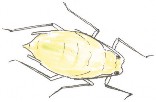
| TABLE 2. Aphids in Montana Alfafa | |
| Spotted Alfalfa Aphid | |
| Description: | This aphid is 1?16" long. It is pale yellow or grayish, and has four to six rows of raised dark spots on the back with small spines emerging from the dark spots. |
| Host plants: | This pest will feed on alfalfa, many clovers and several legumes.It has been found to cause economic damage on alfalfa. |
| Feeding location: | Spotted alfalfa aphids usually feed on the undersurfaces of leaves on the lower aspects of the plant. In warm weather aphids are active and move readily from one plant to another. |
| Misc. comments: | Young alfalfa leaves show a whitening of veins upon initial feeding. Eventually, feeding pressure will cause leaf to curl, turn yellow, die and drop. Heavy infestations will leave a stickyhoneydew that interferes with cutting, drying and baling infested alfalfa. |
| Cowpea Aphid | |
| Description: | Cowpea aphids are shiny, black, 2 to 2.5 mm long, with the first half of the antennae and all of the legs pale yellow or white. |
| Host plants: | This insect is commonly found in lentils, alfalfa, clover, beans, cowpeas, dandelions, mustard and peas. |
| Feeding location: | Feed mainly on the young terminal growth tissues of plants, but can be found infesting leaves, blooms and stems as well. |
| Misc. comments: | Damage symptoms include yellowing, wilting and dieback. In general, legumes can be seriously damaged, either by direct insect feeding or by the transmission of virus diseases. |
| Blue Alfalfa Aphid | |
| Description: | Blue alfalfa aphid resembles the pea aphid, but is more bluish green, and smaller (3 to 3.5 mm long). This aphid has short, black tipped cornicles. |
| Host plants: | Host plants include peas, lentils, alfalfa, clover, and wild legumes. This is a serious alfalfa pest. |
| Feeding location: | Found primarily on young shoots and terminal leaves. |
| Misc. comments: | Conditions that favor outbreaks in alfalfa are extended periods of cool temperatures (50 to 80 degrees F). Large populations have delayed cutting schedules or have caused the loss of an entire fall cutting. |
Spotted Alfalfa Aphid
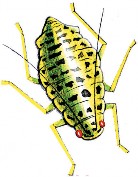
Cowpea Aphid
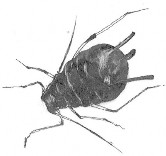
Blue Alfalfa Aphid
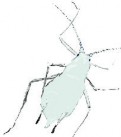
| TABLE 3. Aphids in Montana Potatoes | |
| Potato Aphid | |
| Description: | Potato aphids are light green to whitish colored, with long slender antennae and cornicles. Cornicles are pale, with no dark areas. |
| Host plants: | Only occasionally on small grains. Generally found in corn and potatoes. |
| Feeding location: | Found near the base of the leaf, on the underside. |
| Misc. comments: | Not an important vector of barley yellow dwarf virus. |
| TABLE 4. Aphids in Montana Alfalfa and Potatoes | |
| Green Peach Aphid | |
| Adult Green Peach Aphid | The green peach aphid has converging antennal tubercles as illustrated in a. The diverging tubercles of the potato aphid are shown in b. |
| Description: | The green peach aphid is recognized by three longitudinal dark green stripes on the pale green body. The adults are pear- shaped and 1 to 5 mm in length, with red eyes. |
| Host plants: | This pest is found in a wide variety of vegetable and ornamental crops including spinach, tobacco, alfalfa, potatoes and peaches. |
| Feeding location: | Feed on the underside of leaves. |
| Misc. comments: | High reproductive rate and resistance to pesticides make the green peach aphid a formidable pest in the greenhouse. In addition, this pest vectors a number of plant viruses including tobacco, tomato, lettuce, dahlia, canna and bee mosaics as well as tuber spindle, rugose mosaic and leaf roll diseasesof potato. |
| Pea Aphid | |
| Description: | Color is light to deep green to pink, with reddish eyes. Body length is 2 to 4 mm. Cornicles are long and slender. |
| Host plants: | Pea aphids infest garden and field peas, sweet peas, sweet clover, alfalfa, potato and some leguminous
To download more free online MontGuides or order other publications, visit our online catalog at our store, contact your county or reservation MSU Extension office, or e-mail orderpubs@montana.edu. Copyright © 2023 MSU Extension We encourage the use of this document for nonprofit educational purposes. This document may be reprinted for nonprofit educational purposes if no endorsement of a commercial product, service or company is stated or implied, and if appropriate credit is given to the author and MSU Extension. To use these documents in electronic formats, permission must be sought from the Extension Communications Coordinator, 115 Culbertson Hall, Montana State University, Bozeman, MT 59717; E-mail: publications@montana.edu The U.S. Department of Agriculture (USDA), Montana State University and Montana State University Extension prohibit discrimination in all of their programs and activities on the basis of race, color, national origin, gender, religion, age, disability, political beliefs, sexual orientation, and marital and family status. Issued in furtherance of cooperative extension work in agriculture and home economics, acts of May 8 and June 30, 1914, in cooperation with the U.S. Department of Agriculture, Cody Stone, Director of Extension, Montana State University, Bozeman, MT 59717 |

